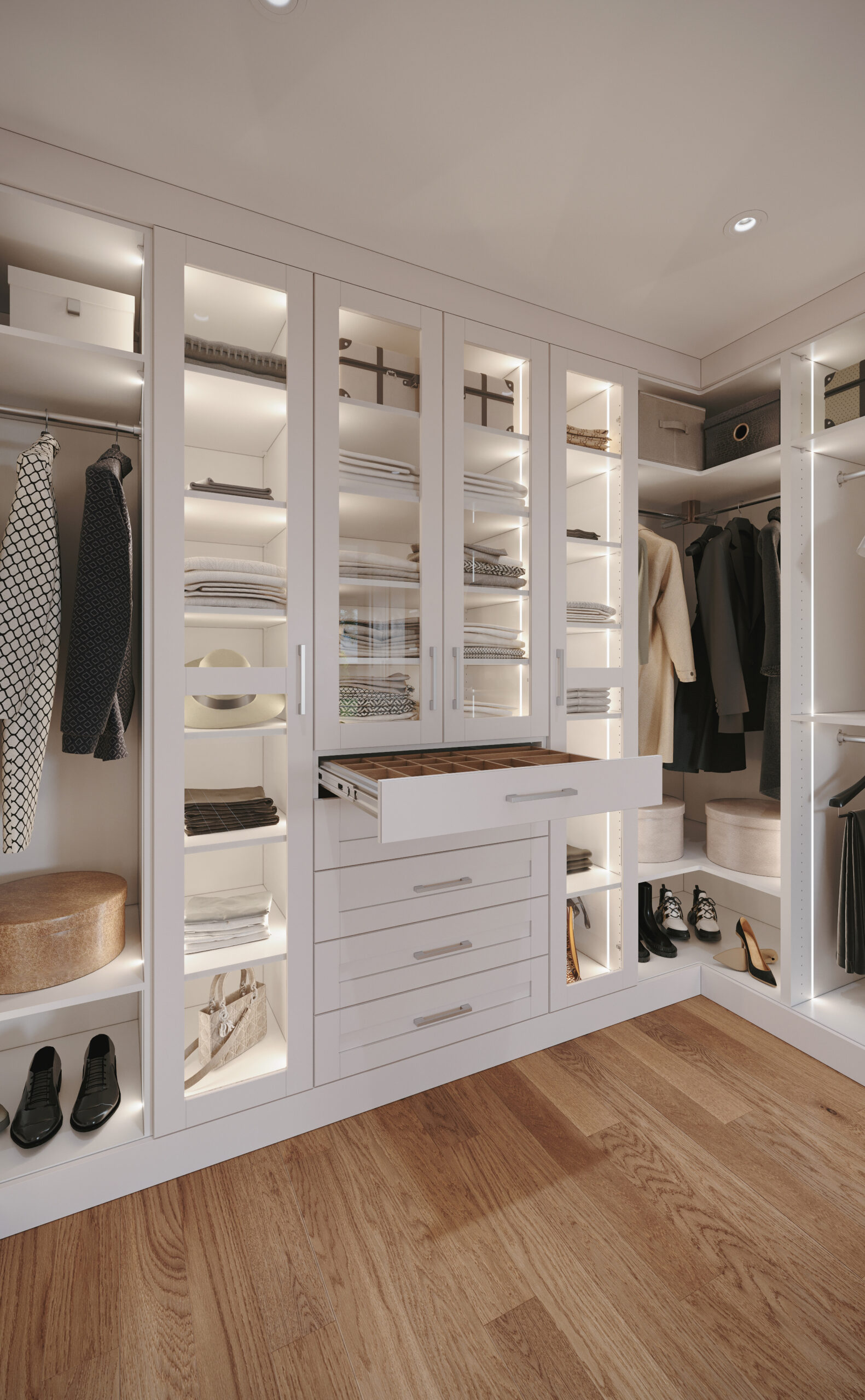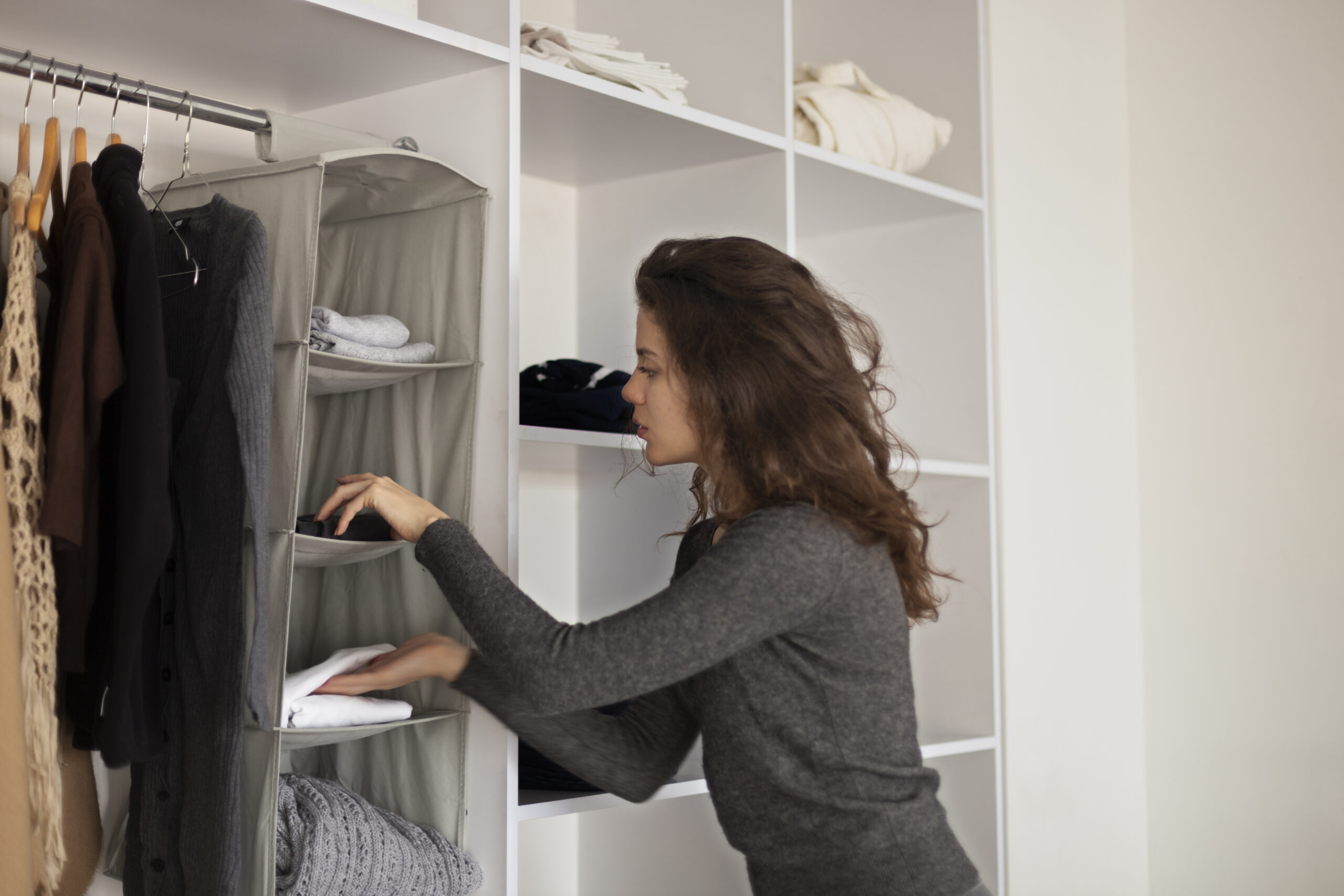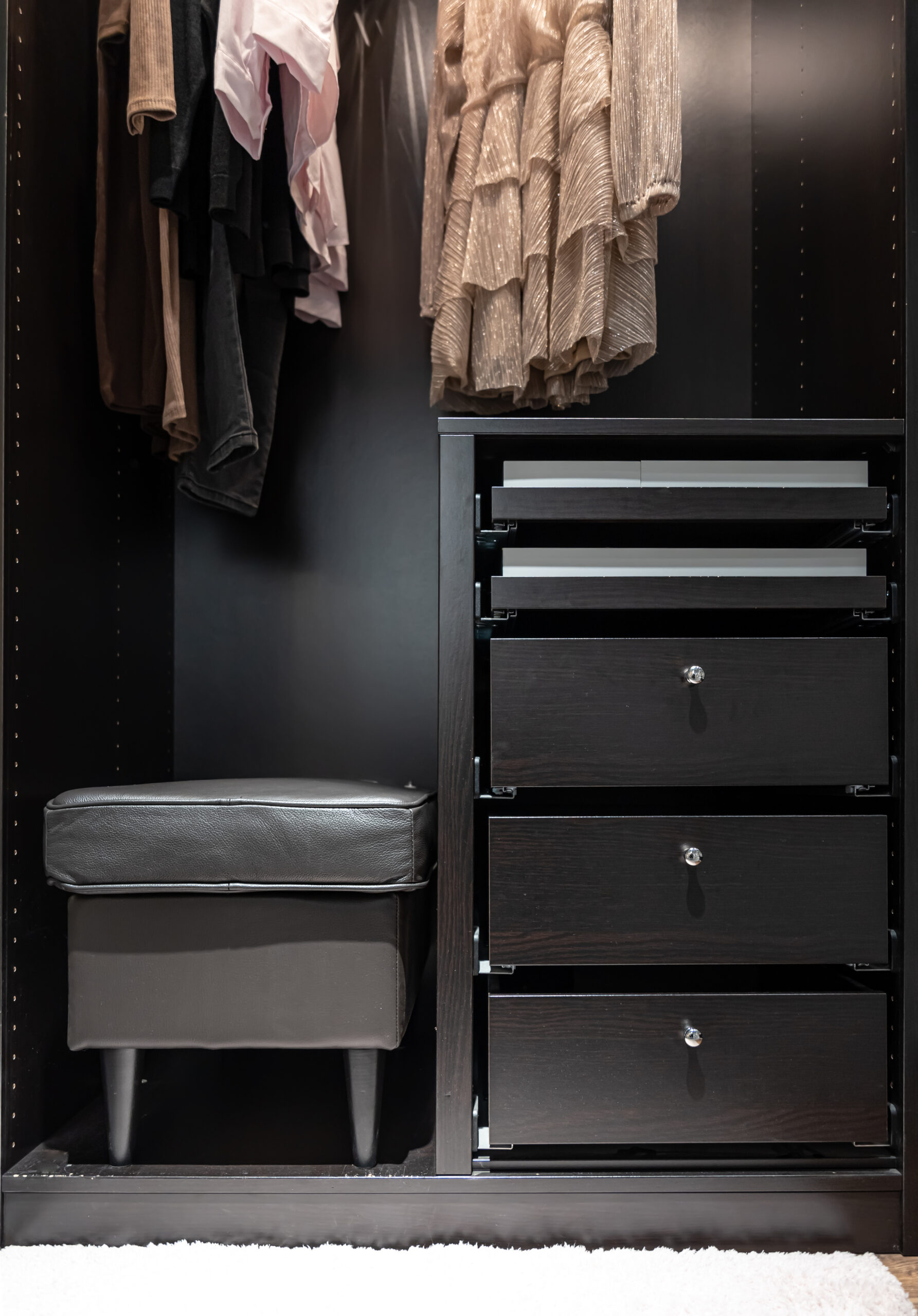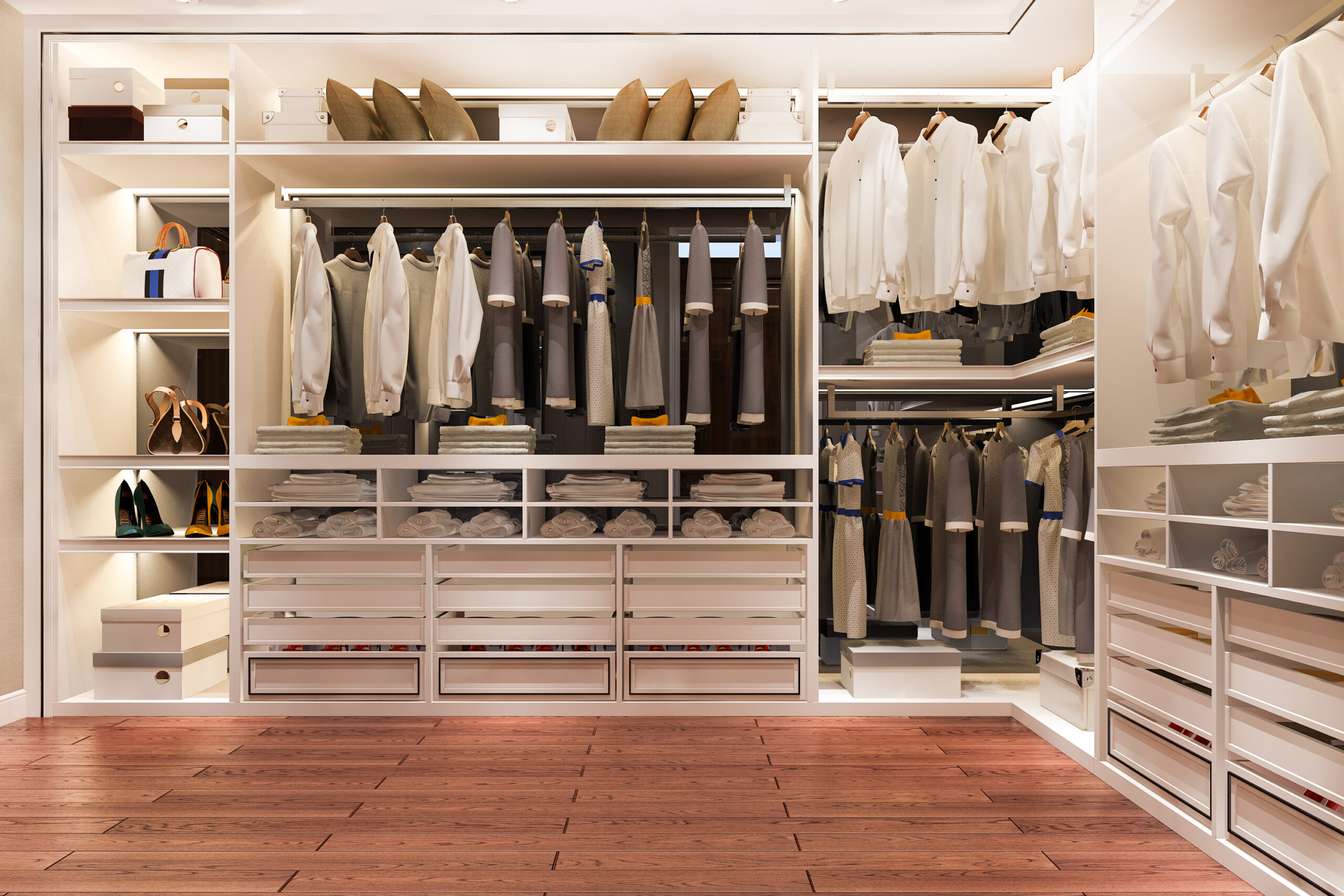DISCOUNTS ARE IN BLOOM! 30% OFF ALL CLOSETS!
Ciri Blog

Transformation with Modular Wardrobe Systems: Design Your Own Space
Introduction to Modular Wardrobe Systems
A modular wardrobe system is a customizable and adaptable storage solution designed to meet individual needs and preferences. Unlike traditional wardrobe setups, these systems offer flexibility in design while optimizing functionality. Built on a versatile framework, they allow for adjustments in size, configuration, and style. Modular wardrobes have become increasingly popular for their ability to transform living spaces into organized, seamless areas that reflect personal tastes.
Modular wardrobe systems exemplify innovation in interior design. They are typically comprised of interchangeable units, such as shelves, drawers, and hanging sections, which can be reconfigured to suit a variety of requirements. These systems cater to both aesthetic and practical dimensions, offering sleek designs, durable materials, and an array of finishes to match existing decor while ensuring efficient utilization of space.
Key benefits of modular wardrobe systems include their adaptability and scalability. They can be designed for small apartments or expansive walk-in closets, making them ideal for urban and suburban lifestyles alike. Their ease of installation adds to their appeal, as homeowners or designers can assemble components with minimal hassle. Furthermore, these systems often incorporate clever features like sliding doors, pull-out racks, and built-in lighting, enhancing both convenience and visual appeal.
The process of choosing a modular wardrobe begins with assessing the available space and understanding the user’s specific needs. Modular units can be selected to prioritize hanging space for garments, compartments for accessories, or drawers for folded items. Incorporating mirror panels, textured finishes, or bold colors further allows customization to achieve a personalized aesthetic. Transitioning seamlessly between form and function, they enable homeowners to create tailored storage solutions that blend practicality and style.
Ultimately, modular wardrobe systems provide a contemporary approach to organization, empowering individuals to design spaces that evolve alongside their needs.
Benefits of Adopting Modular Wardrobe Solutions
Modular wardrobe systems offer a wide array of advantages, making them a popular choice for homeowners seeking functional and aesthetically pleasing storage solutions. Their adaptability, efficiency, and innovative design allow individuals to optimize their space while meeting specific organizational needs.
1. Customizability and Flexibility
Modular wardrobes provide a high degree of customization, enabling users to tailor layouts, sections, and finishes to align with their lifestyle and preferences. Adjustable shelves, varied compartments, and an array of configurations allow these systems to accommodate diverse storage demands over time. They easily adapt to changes such as additions to a wardrobe or space reorganization.
2. Efficient Space Utilization
These solutions maximize the use of available space, even in challenging areas like corners and sloped ceilings. By offering a structured design that eliminates wasted gaps, modular wardrobes provide organized storage while maintaining a clutter-free appearance.
3. Enhanced Organization
Incorporating features such as pull-out trays, dedicated sections for shoes and accessories, hanging rods, and drawer systems, modular wardrobes allow for systematic arrangement of belongings. This eliminates the frustration of misplaced items and helps streamline daily routines.
4. Aesthetic Appeal
Available in a variety of colors, materials, and finishes, modular wardrobe systems seamlessly enhance the overall interior aesthetics. From sleek modern designs to more traditional styles, they integrate effortlessly with the décor of the room.
5. Durability and Cost Efficiency
Built with high-quality materials and advanced craftsmanship, modular wardrobes are designed to endure wear and tear, providing long-term value. Their modular nature also ensures cost efficiency, as individual components can be replaced or upgraded without requiring a complete overhaul.
6. Eco-Friendly Options
Many manufacturers offer modular wardrobe solutions crafted from sustainable or recycled materials. This environmentally conscious feature appeals to individuals seeking greener alternatives for their home interior designs.
By combining functionality, visual appeal, and practical adaptability, modular wardrobe systems elevate not only the storage capacity of a space but also its overall livability and style.
Understanding Space Optimization with Modular Designs
Modular wardrobe systems offer a practical approach to optimizing space, ensuring that every square inch serves a purpose. By leveraging modular design principles, homeowners can create personalized storage solutions tailored to their unique needs while maximizing functionality in any area, whether small or expansive. These systems are characterized by their versatility, allowing components to be adjusted, added, or removed in response to changing preferences or spatial constraints.
Combining modular elements, such as customizable compartments, varied shelving options, and adjustable hanging rods, ensures greater accessibility and efficiency. Modular wardrobe designs often prioritize vertical space utilization. This approach minimizes wasted areas by making use of walls and higher ceilings for added storage. Incorporating stackable drawers or extendable racks enables seamless organization while promoting accessibility.
Key features of modular wardrobes include:
- Adaptability: Modular systems easily adapt to diverse storage requirements, accommodating clothing, accessories, or even unique items like footwear or bags.
- Scalability: Components can be scaled up or down, based on available space, offering flexibility for growth or downsizing without compromising functionality.
- Aesthetic Balance: Modular designs also integrate style with utility, allowing individuals to choose finishes, materials, and colors that complement their interiors.
These systems enable the user to reduce clutter while offering unobstructed access to items. Furthermore, modular wardrobes can incorporate innovative elements like pull-out mirrors, sliding doors, or partition organizers for specialized compartments, thereby enhancing both practicality and aesthetic appeal.
Through careful planning and modular principles, every corner of the room can be transformed into usable storage space while maintaining a streamlined and harmonious look. Modular wardrobe systems provide an elegant, efficient solution to modern storage challenges, making them a preferred choice for various lifestyles, spaces, and design preferences.
Personalization: Tailoring Wardrobe Systems to Your Needs
Modular wardrobe systems are designed to adapt not only to the space they occupy but also to the specific needs of the individual using them. Personalization is at the core of these systems, offering the perfect blend of functionality and style. By focusing on flexibility, users can create wardrobe solutions tailored to their unique requirements, ensuring every element serves a purpose.
Customization options begin with the layout. Individuals can choose configurations that best suit their storage habits, such as a combination of open shelving for frequently used items, pull-out drawers for accessories, and hanging rods for clothing. For those with specific wardrobe collections, such as evening wear or seasonal items, taller compartments or adjustable shelving may be incorporated to accommodate their needs.
To enhance utility, modular systems can include organizers tailored to specific items. Options like tie racks, jewelry trays, shoe compartments, and pull-out baskets ensure that belongings are stored systematically. These systems also accommodate unique features, such as built-in laundry hampers or media compartments, highlighting their versatility.
Material selection allows further personalization, with choices ranging from sleek, minimalist finishes to classic wood grains. Additionally, users can integrate lighting solutions, such as LED strips or spotlights, for added visibility and ambiance. These choices ensure perfect alignment between aesthetics and function.
Modular wardrobe systems can also reflect personal habits. For example, wardrobes designed for children may feature lower shelves and hanging rods for easy access, while systems for professionals may prioritize efficient organization for work attire and accessories, fostering productivity. These features provide users with an individualized yet cohesive storage solution.
Materials and Finishes: Choosing the Right Look for Your Space
Selecting the appropriate materials and finishes for a modular wardrobe system plays a crucial role in defining the aesthetic and functionality of a space. The choices available are vast, encompassing a range of textures, colors, and durability levels that can complement virtually any design style, from modern minimalism to timeless elegance.
When it comes to materials, engineered wood, solid wood, laminate, and metal are among the most commonly utilized options. Engineered wood offers durability and budget-friendliness, while solid wood provides a premium look with natural grain patterns. For a sleek, contemporary appearance, metal accents or full-metal solutions are often favored, particularly in industrial-style interiors. Laminate, on the other hand, is highly versatile, available in a wide range of colors and finishes, and resistant to wear and tear.
Glass and mirrors add an elegant touch and can make small spaces feel larger. Frosted, tinted, or clear glass panels can be used for doors or accents, offering both style and functionality. Additionally, mirrored finishes can eliminate the need for a separate dressing mirror, optimizing space use.
Finishes further enhance the overall design. Options include matte, gloss, textured, or woodgrain finishes, each adding a unique character. Matte finishes create a sophisticated, understated look, while gloss finishes reflect light for a more vibrant and polished appearance. Textured details, such as embossed surfaces, introduce depth and contrast. For those seeking a natural aesthetic, woodgrain finishes provide a warm, organic feel.
Color choices also influence the visual impact of the wardrobe. Neutral tones like white, beige, and gray promote a clean, minimalist appeal. For a bolder statement, darker hues or vibrant colors can become focal points in the room, creating contrast and visual interest.
To ensure optimal results, it is essential to match the materials and finishes with the surrounding decor and personal requirements. Durable, easy-to-maintain options are particularly critical in high-usage areas.
Flexibility and Scalability in Modular Wardrobe Systems
Modular wardrobe systems offer unparalleled flexibility, enabling users to tailor storage solutions that fit their individual needs and preferences with ease. Unlike static wardrobes, modular designs accommodate the dynamic nature of lifestyle changes, allowing components to be reconfigured, expanded, or minimized. These systems adapt seamlessly to varying spatial constraints, ensuring efficient utilization of available room while maintaining aesthetic integrity.
At their core, modular wardrobes operate on interchangeable units, granting users the freedom to select components such as hanging spaces, shelves, drawers, shoe racks, and accessory organizers. This customizable approach accommodates diverse storage demands, whether for formal wear, casual clothing, or a burgeoning collection of footwear. Additionally, adjustable parts within these systems cater to changing circumstances, such as transitioning from solo accommodations to shared living spaces.
Scalability serves as a key feature, allowing systems to grow alongside evolving needs. Users moving into larger residences can simply add extra modules without the need to replace their existing setup. On the other hand, compact configurations can be created to suit smaller spaces. By employing adaptable designs, manufacturers ensure these wardrobes remain relevant over time, mitigating the necessity for premature replacement and contributing to sustainable consumption practices.
Furthermore, modular wardrobe systems often include innovative designs that integrate accessories like mirrors, lighting components, hanging rods, dividers, and pull-out mechanisms for seamless functionality. These features enhance usability while responding dynamically to personal preferences. The ability to reorganize and customize not only optimizes storage efficiency but also permits homeowners to remain organized without compromising convenience or style.
Thanks to their flexibility and scalability, modular wardrobe systems empower individuals to enjoy a storage solution that grows and evolves, aligning perfectly with their personal requirements and spatial constraints.
Designing for Functionality: Storage and Organization Options
Designing a modular wardrobe system requires careful attention to functionality, with an emphasis on creating efficient storage and organization solutions tailored to specific needs. Modular wardrobes are designed to maximize space while accommodating diverse storage requirements, making them ideal for various lifestyles and preferences. By incorporating flexible features, users can optimize every inch of the wardrobe, transforming clutter into a seamless, well-organized system.
Customization begins with choosing the right storage components. Options include shelves for folded garments, hanging rails for formal attire, and customized compartments for accessories such as belts, ties, or scarves. Drawers with dividers provide a smart solution for storing smaller items like socks and undergarments, ensuring accessibility without compromising order. Adjustable shelving units further enhance versatility, allowing space to be modified as needs change over time.
A well-designed modular wardrobe also prioritizes specialized compartments to focus on specific organizational preferences. Shoe racks, pull-out trays, and stackable storage boxes serve as essential elements for grouping items by category. Additionally, slide-out jewelry organizers and built-in mirrors can add functionality to the design. For those with space restrictions, options such as corner shelves or pull-down hanging rods maximize vertical storage while maintaining a sleek aesthetic.
Lighting plays a pivotal role in enhancing functionality. LED strip lights or motion-sensor lighting solutions help illuminate darker sections of the wardrobe, enabling users to locate items efficiently. Accessories such as hooks, swivel hangers, and pull-out trouser racks can further elevate organization systems to meet unique requirements.
When designing for practicality, materials and finishes should also be considered. Durable components ensure longevity, while easy-to-clean surfaces make maintenance simple. By combining these customizable options, a modular wardrobe system becomes a personalized storage solution that adapts to an individual’s needs and preferences. This tailored approach ensures organization remains both dynamic and purposeful throughout its use.
Incorporating Modern Trends into Modular Wardrobe Designs
The evolution of modular wardrobe systems integrates modern trends, bridging aesthetics and functionality. Designers increasingly prioritize minimalism, drawing inspiration from clean lines and neutral palettes. This approach enhances a space’s visual appeal while allowing maximum adaptability for diverse interiors. Modular wardrobes now frequently incorporate sleek finishes such as matte and high-gloss surfaces, adding a contemporary touch to any setting.
Technological integration is an emerging trend shaping modular wardrobes. Smart lighting solutions, such as motion-activated LED strips inside compartments, enhance visibility while maintaining energy efficiency. Customizable shelving with charging docks accommodates modern gadgets, blending practicality with style. Automatic closing mechanisms offer convenience and echo the growing preference for seamless, tech-enabled design in home interiors.
Sustainability plays a significant role in modern designs. The adoption of eco-friendly materials like recycled wood and water-based finishes aligns with environmental values, while modularity itself reduces waste through reusability and repurposing. Consumers increasingly favor these sustainable options, contributing to a broader push toward green interior solutions.
Customization remains a key component, driven by the demand for personalized spaces. Sliding doors with mirrored or textured glass panels, modular accessories, and adaptable compartments cater to varied tastes and storage needs. Trending colors, such as muted pastels or rich jewel tones, provide diverse options for homeowners seeking individuality without compromising practicality.
The fusion of style, technology, and sustainability underscores modern modular wardrobes. With their adaptable nature, these designs embrace innovations while responding to current preferences, creating multifunctional spaces that harmonize with contemporary lifestyles. By integrating these trends, modular wardrobes uphold their relevance in ever-evolving interior design landscapes.
Cost-Effective Alternatives to Traditional Wardrobes
Modular wardrobe systems present a practical and budget-friendly solution for those looking to optimize storage without compromising design aesthetics. Unlike traditional wardrobes, which often come in fixed dimensions and styles, modular options are customizable and scalable, allowing users to create tailored configurations to meet their specific needs. These systems are ideal for maximizing space utilization, especially in compact rooms or unconventional layouts.
One of the most notable advantages of modular wardrobes is the ability to mix and match components. Modular systems typically include items such as shelves, drawers, hanging rods, and shoe racks. By selecting only the necessary elements, users reduce costs by avoiding unnecessary features found in pre-built wardrobes. Additionally, modular wardrobes can often be assembled without professional assistance, reducing installation costs significantly.
Benefits of Modular Wardrobes
- Adaptability: Modular systems can be adjusted as needs change, eliminating the need for costly replacements. Done with additional storage? Simply add another module without discarding the existing setup.
- Material Options: Many modular wardrobes come in affordable yet durable materials, such as engineered wood, particle board, or metal, enabling budget-conscious choices without sacrificing durability.
- DIY Assembly: These systems are often designed for easy installation, allowing homeowners to save on labor costs, as many components snap together or require basic tools.
- Extendable Design: As wardrobe extensions are readily available, users can scale up their setup if required over time instead of investing in an entirely new unit.
Moreover, manufacturers of modular wardrobes often offer designs that mimic high-end styles, giving users access to premium aesthetics at a fraction of the price. With minimalist, contemporary, and even vintage options available, modular wardrobes cater to varied design preferences. This versatility makes them an excellent choice when balancing cost-efficiency and customization.
Efficient production techniques and materials used in modular systems also contribute to their affordability. Prefabricated modules are produced in bulk, reducing manufacturing costs which are then passed down to the consumer. Additionally, modular wardrobes support sustainability by enabling selective replacements; damaged sections can be swapped out individually, minimizing waste as opposed to disposing of an entire unit.
Transitioning from traditional wardrobes to modular systems offers a transformative way to personalize storage while saving money. Their modular nature, combined with aesthetic and functional variability, makes them an appealing alternative for varied living spaces.
Tips for Measuring and Planning Your Wardrobe Layout
An effectively designed wardrobe system begins with accurate measurements and a well-thought-out plan. Proper preparation ensures the wardrobe will not only fit the designated space but also meet functional needs seamlessly. To create an ideal layout, one must carefully approach both spatial utilization and personal storage requirements.
Accurate Measuring Techniques
- Measure the Available Space: Use a tape measure to determine the exact width, height, and depth of the area where the wardrobe will be installed. Account for any molding, skirting boards, or architectural features that might affect placement.
- Consider Floor and Ceiling Irregularities: Measure at multiple points along the floor and ceiling to check for uneven dimensions. This ensures the wardrobe fits snugly.
- Allow for Clearance: Leave sufficient space for doors or drawers to open fully, whether using hinged, sliding, or bi-fold mechanisms.
Defining Storage Needs
- Assess Wardrobe Contents: Make an inventory of clothing, footwear, accessories, and other items. Categorize the items into groups such as hanging garments, folded clothing, or small accessories.
- Plan for Growth: Estimate future storage requirements for items you might acquire. Having built-in flexibility ensures the wardrobe remains functional over time.
Modularity for Customization
Choosing modular components allows for tailoring the design to suit individual needs. Adjustable shelves can accommodate changing storage requirements, while customizable hanging rails cater to garments of varying lengths.
Utilizing Vertical and Horizontal Space
Make efficient use of the wardrobe’s dimensions by incorporating tiered sections. High shelves are ideal for seasonal items, while eye-level compartments make daily essentials easier to access. Shallow drawers or pull-out trays provide excellent storage solutions for smaller items like jewelry or scarves.
Visualizing the Layout
Sketching a scaled plan of the wardrobe layout aids in visualizing the final appearance. Online wardrobe design tools or consultation with specialists can identify potential issues and suggest improvements before installation begins.
Maintenance and Longevity of Modular Wardrobes
Proper care and regular maintenance are essential for ensuring the longevity of modular wardrobe systems. These versatile storage solutions are designed for durability, but their performance and aesthetic appeal can diminish without consistent upkeep. Understanding the appropriate steps to preserve them will maximize functionality and prolong their life span.
Key Maintenance Practices
- Cleaning and Dusting: Dust and debris can accumulate on surfaces and within compartments over time. Modular wardrobes benefit from routine dusting with a microfiber cloth or feather duster. For deeper cleaning, using a damp cloth and mild detergent on non-wood surfaces ensures cleanliness without causing damage.
- Inspection for Wear: Regular assessments to identify signs of wear on hinges, sliding mechanisms, or handles are crucial. Loose screws, misaligned tracks, or worn-out gliders should be attended to promptly since neglect can compromise the overall structural integrity of the unit.
- Lubrication of Moving Parts: Sliding doors and drawers require periodic lubrication to maintain smooth operation. Silicone-based lubricants are ideal for keeping metal tracks and rollers functional without attracting unnecessary dirt or residue.
- Avoiding Overloading: Exceeding specified weight limits for shelves and compartments may lead to sagging or damage over time. Adhering to stated capacity guidelines helps maintain the stability and reliability of the structure.
- Temperature and Humidity Control: Modular wardrobes are sensitive to moisture, especially wooden or laminate components. Ensuring a stable, dry environment protects against warping, swelling, or peeling and prevents mold or mildew growth.
Factors Impacting Longevity
Several external factors contribute to a modular wardrobe’s durability. Exposure to direct sunlight can fade finishes, while impacts caused by improper use may dent or scratch materials. Investing in high-quality modular systems and using protective inserts or linings helps mitigate these effects. Additionally, opting for professional installation ensures accurate assembly that can withstand the test of time.
Environmental Benefits: Sustainability in Modular Systems
Modular wardrobe systems contribute positively to sustainable design practices by promoting resource efficiency and reducing waste. Their production often incorporates eco-friendly materials such as sustainably sourced wood, recycled metals, or low-VOC finishes, minimizing environmental impacts. Unlike traditional fixed wardrobes, modular systems are designed with longevity in mind, reducing the need for frequent replacement and conserving resources in the long term.
The adaptability of these systems also aids in curbing material waste. With customizable configurations, users can modify or expand their wardrobe units as needs evolve, eliminating the disposal of outdated furniture. Such systems allow for reusability, as components can often be repurposed for other uses or shared across households, fostering a circular economy mindset.
Manufacturers of modular wardrobes also frequently adopt energy-efficient production processes. These practices often result in lower carbon emissions compared to mass production techniques used for conventional furniture. By prioritizing energy savings, companies contribute to mitigating climate change while meeting consumer demand for green products.
Transportation efficiency is another environmental advantage of modular systems. Flat-pack designs require less packaging and allow for optimized shipping, reducing the carbon footprint associated with transportation. This streamlined logistics approach further reinforces the sustainability goals of modular furniture.
Additionally, modular wardrobes support conscious consumption by encouraging buyers to select precisely what they need instead of over-purchasing. The scalability of these systems ensures that users only invest in necessary components, reducing overproduction and its environmental consequences.
Through innovative designs and mindful production, modular wardrobe systems exemplify how modern furniture can align with eco-conscious values, safeguarding the environment for future generations.
Professional vs DIY Installation: What to Consider
When integrating modular wardrobe systems into a living space, deliberation over professional versus DIY installation is crucial to ensure effective implementation. Understanding the key factors can guide homeowners toward the most suitable option based on their capabilities, budget, and desired outcomes.
Factors to Keep in Mind for DIY Installation
Undertaking DIY installation requires a thorough assessment of one’s tools, time, and skill level. Modular systems often consist of components that need precise measurement and alignment.
- Skill Requirements: DIY installation presumes basic knowledge of assembly, hardware tools, and spatial planning. Errors such as incorrect measurements or improper mounting could compromise the system’s functionality and durability.
- Tools and Equipment: Ensuring access to essential tools like drills, levels, and saws is necessary. Missing or inadequate tools can hinder progress, leading to additional expenses or incomplete installations.
- Time Commitment: Installing a system independently requires dedicating sufficient time. Larger or more intricate wardrobes could involve lengthy assembly processes, which may disrupt daily routines.
- Customization Challenges: Achieving tailored adjustments may be difficult for individuals inexperienced in carpentry or design. Detailed structural changes such as cutting shelves or resizing frames call for precise expertise.
Advantages of Professional Installation
Opting for professional installation offers added reliability and efficiency. Experienced installers bring technical expertise and industry-grade tools, ensuring a seamless process.
- Precision and Accuracy: Professionals are trained to ensure all components fit and align correctly, reducing risks of errors or rework.
- Time Efficiency: Compared to DIY, professionals can complete the installation in a shorter timeframe, minimizing inconvenience.
- Handling Complex Configurations: For more complicated layouts or custom builds, professionals streamline the integration of unique designs, maximizing the wardrobe’s visual and functional appeal.
- Warranty Benefits: Professional services often include warranties for their work, offering peace of mind for homeowners in case of post-installation issues.
Cost Considerations
Budget constraints also play a role in the decision-making process. While DIY installations may reduce upfront costs, unforeseen expenses from mistakes could offset savings. Professional installation entails an additional fee but guarantees quality results. Carefully comparing expenses and evaluating long-term benefits can clarify the best path forward.
Understanding the distinctions between DIY and professional installation sets a foundation for making a confident decision regarding modular wardrobe systems.
Final Thoughts: Transforming Your Living Space with Modular Wardrobe Systems
Modular wardrobe systems offer a unique combination of versatility and design freedom, making them an exceptional solution for modern living spaces. Unlike traditional wardrobes, modular systems empower users to create customized storage setups tailored to their specific needs, making optimal use of available space while enhancing functionality.
One of the key advantages of modular wardrobes is their adaptability. They can be adjusted and reconfigured to fit into various room layouts, whether the area is expansive or compact. This flexibility makes them an ideal choice for individuals who aim to integrate practicality with style. Modular systems also make it possible to address storage challenges such as underutilized corners or sloped ceilings, often overlooked in traditional designs.
Additionally, these systems provide a wide range of materials, finishes, and modular components. From glass shutters and matte laminates to open shelving and pull-out drawers, the customization options are virtually endless. They not only reflect personal preferences but also elevate the aesthetics of a room. Incorporating lighting elements or mirrored panels further enhances functionality while adding a sense of sophistication.
Modular wardrobe systems also simplify the process of staying organized. Features such as dedicated compartments for shoes, slide-out racks for ties, and separate sections for seasonal clothes ensure that every item has its place. Accessories like soft-close hinges and adjustable hanger rods enhance usability, creating a seamless experience.
Transitioning to a modular wardrobe setup also promotes sustainability. Some manufacturers offer eco-friendly materials and durable designs that reduce long-term waste. This makes modular wardrobes a responsible investment for those looking to balance functionality and environmental consciousness. By prioritizing modularity, homeowners have the opportunity to redefine their living spaces effectively and efficiently.
Devon Lane

- Genel (16)
- Home Improvement (3)
- Reinvent Your Wardrobe with Modular Shelving Systems 08/26/2025
- Create Your Own Dressing Room: Walk-In Closet Ideas and Inspiration 08/18/2025
- Big Solutions for Small Spaces: Organized Living with Modular Closet Systems 08/10/2025
- 5 Easy Cabinet Assembly Tips for Hassle-Free Pi Closets Installation 08/02/2025
- 10 Genius Shoe Storage Solutions: Try a Shoe Cabinet with Drawers 07/25/2025






